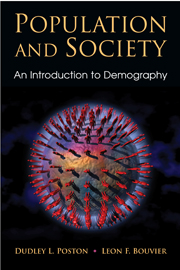Book contents
- Frontmatter
- Contents
- Preface
- Introduction
- 1 “We Are All Population Actors”: An Introduction to Demography
- 2 The Sources of Demographic Information
- 3 Fertility
- 4 Contraception and Birth Control
- 5 Mortality
- 6 Internal Migration
- 7 International Migration
- 8 Age and Sex Composition
- 9 World Population Change over Time
- 10 Population Change in the United States
- 11 Population Distribution
- 12 Cultural Adaptation and Growth
- 13 Population Policy
- 14 The Future of Planet Earth
- Glossary
- References
- Author Index
- Subject Index
8 - Age and Sex Composition
- Frontmatter
- Contents
- Preface
- Introduction
- 1 “We Are All Population Actors”: An Introduction to Demography
- 2 The Sources of Demographic Information
- 3 Fertility
- 4 Contraception and Birth Control
- 5 Mortality
- 6 Internal Migration
- 7 International Migration
- 8 Age and Sex Composition
- 9 World Population Change over Time
- 10 Population Change in the United States
- 11 Population Distribution
- 12 Cultural Adaptation and Growth
- 13 Population Policy
- 14 The Future of Planet Earth
- Glossary
- References
- Author Index
- Subject Index
Summary
INTRODUCTION
Of all the characteristics of human populations, age and sex are the most important and relevant for demographers. They are so important for demographic analysis that they are referred to as “the demographic variables” (Bogue, 1969: 147). The demographic processes of fertility, mortality, and migration produce the population's age and sex structure (Horiuchi and Preston, 1988), and the age and sex structure influences the demographic processes. As we have already shown in Chapter 1, there is a very close relationship between the demographic variables and the demographic processes.
The importance of age and sex extends considerably beyond demography, however. The division of labor in traditional societies is based almost entirely on age and sex. In fact, age and sex differences of one form or another are found in all known human societies (K. Davis, 1949: Chapter 4; Murdock, 1949: Chapters 1 and 8).
At the individual level, age and sex are of such tremendous importance in our daily life that usually we do not know we are observing them. Whenever we walk across campus or on the streets where we live, what are the first two characteristics we recognize about an approaching person? The person's sex and a rough notion of his or her age, that is, whether the person is a baby, an adolescent, a young adult, a middle-aged person, or a senior. We make these determinations mainly on the basis of outward appearances, and we make them so automatically that they are done subconsciously.
- Type
- Chapter
- Information
- Population and SocietyAn Introduction to Demography, pp. 228 - 264Publisher: Cambridge University PressPrint publication year: 2010
- 2
- Cited by



